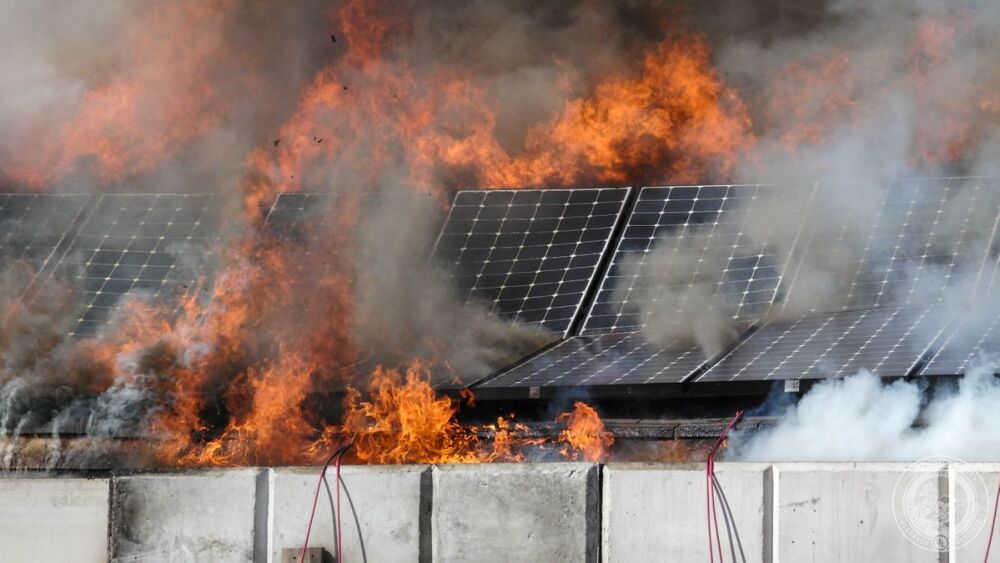Basic firefighter strategies and tactics needed to mitigate a residential structure fire have changed with the installation of thousands of solar panel and battery energy storage systems (ESS) in homes across the United States. As such, firefighters need updated training that addresses the presence of this technology. Let’s review a bread-and-butter approach to mitigating a residential structure fire involving solar panels and battery storage systems.
Solar panel fire attack
On a residential structure fire where an aggressive interior fire attack strategy has been declared, one of the initial benchmarks for command is to control utilities. This critical task needs to be accomplished so that the firefighters inside the structure can safely complete a primary life search, locate and extinguish the fire, and contain it to the room of origin.
Fire service training on electrical utility control and extinguishment has evolved little in the past 100 years. However, the introduction of alternate energy systems has changed where power flows and how it is made safe. With this in mind, the following six critical simple steps can impact firefighter life safety and lead to the successful mitigation of the incident.
1. Complete a 360 to locate energy storage systems
The-first arriving member should complete a 360-walkaround of the building, if possible, to locate any solar panels and or energy storage systems (ESS) present. Many such systems will be located outside, in a garage or basement, depending on the region and building codes.
The one common thread across the country is that building codes require a placard be installed on the outside of the residence indicating to firefighters that a solar/battery system has been installed and where the system and shutoffs are located. This placard is usually placed on the electrical utilities box on the exterior of the house or on the system itself if it is located outside.
2. Turn off all power systems
The unit assigned to control utilities needs to understand that electricity to the home is only isolated once the main breaker from the grid utility and the DC/AC disconnect from the solar and storage have been turned off. Turning off only the main utility breaker will activate the backup battery to the home, so it is imperative to turn off all the systems to eliminate the possibility of the interior firefighters receiving an electric shock.
If the ESS is on fire and firefighters need to gain access to it, whether it is in the garage, basement or located outside, the damage from direct flame impingement can cause the system to start degrading and may cause thermal runaway. Thermal runaway is the process where self-heating occurs faster than can be dissipated, resulting in vaporized electrolyte, fire and/or explosions.
If the battery is in a confined space and exposed to any internal or external heat above 150 degrees F, then it is critical that firefighters ventilate the space first. Once the space has been adequately ventilated, firefighters can attempt to extinguish the fire if needed and then evaluate whether the ESS needs to be isolated.
3. Be smart about ventilation tactics
If the incident commander (IC) calls for vertical ventilation to help interior crews complete their life-saving functions, firefighters need to be aware of two important facts. First, electricity can be produced by the solar panels day or night, depending on the light source. In a UL study, 800V and 340mA were measured coming from a 1000V array at night. The light source creating this electricity was from apparatus spotlights directed at the solar panels. With the capability of solar panels to create electricity day or night that travels through conduit, firefighters should not cut, damage or touch any part of the system.
Second, if the conduit is hidden, which it normally is for aesthetic reasons, a firefighter cutting a hole in a roof unaware of the conduit’s location could easily be exposed to an electrical shock. The simplest and safest strategy is for firefighters to stay off the roof. They should be instructed to not touch the panels or conduit and only vertically ventilate if they can locate a stable part of the roof that is clear of the solar panels and conduit.
If a roof is discovered to have multiple solar panels covering the majority of it, the IC should immediately consider using vent, enter, isolate, search (VEIS) or horizontal ventilation.

After Hurricane Maria caused the failure of the electrical grid across Puerto Rico in 2017, Birt spearheaded a disaster relief effort that resulted in 15 solar and battery micro grids being installed on strategically placed fire stations across the island to keep the emergency services operational. Here, Captain Birt leads first responders in solar/ESS training in Puerto Rico. (Photos/Richard Birt)
4. Commence fire attack – from a distance
If the solar panels on the roof of a residential structure are burning, firefighters need to understand that the back of the solar panels are made of combustible material and can burn very easily. They also need to recognize that a large volume of fire in or around the solar panels could mean the roof is burning as well as the panels that may lead the IC to call for a defensive operation.
Firefighters can safely extinguish the fire by applying a straight stream from a minimum of 20 feet away or use a fog pattern from 5 feet away. Grid utility electricity coming from the local power company to the house has not changed and the firefighters need to recognize this and follow their standard operating procedures (SOPs) for working with existing residential utility electrical service. Foam is not needed to extinguish a solar panel or battery fire. In fact, testing has shown that plain water is the most effective tool.
5. Apply the same strategies to a battery fire
If a battery (energy storage system) is burning or involved in a residential structure fire, whether it is in a garage, the side of a home or basement, firefighters can apply the same fire flow principles as the solar panel fire. Specifically, if the battery is in a confined space, firefighters should first effectively ventilate the area, then approach it in full firefighting PPE, including SCBA, and start flowing water at a minimum distance of 20 feet with a straight stream.
As the crew advances, they can switch to a fog pattern to safely extinguish the fire from 5 feet away. Firefighters need to approach the battery from the side because the solid metal casing covering the front of the battery will deflect the water stream away from the burning cells.
A note on temperature: When actively burning, batteries can produce temperatures in excess of 1,200 degrees F, and reach thermal runaway temperature between 300 to 400 degrees F. The batteries can start degrading at temperatures as low as 200 degrees, causing them to produce combustible toxic gases that will need to be aggressively ventilated. If the battery is stored in a confined area, like a closet or basement, and has been exposed to temperatures above 150 degrees F, it is critical that firefighters adequately ventilate the area first before making entry.
6. Perform overhaul – carefully
After a residential fire involving solar panels and batteries has been extinguished, firefighters must be cautious during overhaul.
Solar panels need to be evaluated by a certified electrician after every structure fire because of the possible damage to them and the wires that run through the conduit to the charge controller or inverter. Firefighters should not touch any part of the system until this has been accomplished. The two exceptions are if the firefighters can cover the panels without coming in direct contact with either the panels or conduit, or if the fire started at night and the panels are not being exposed to any sources of light. Black plastic sheeting at least 3 mm thick or traditional canvas tarps are highly effective for completing this overhaul technique. Covering the panels at night with no exposure to a significant light source can help the homeowner because of the possibility of a delay in contacting a certified electrician.
After a battery has been extinguished, firefighters should keep flowing copious amounts of water on the battery to cool it down to ambient air temperature. Cooling the battery after extinguishment will reduce the possibility of a chemical reaction occurring in the damaged battery cells. If the cells are not sufficiently cooled, temperatures could rise and lead to thermal runaway. Burn tests with lithium-ion Batteries have shown that damaged battery cells can create enough heat to cause a fire even 72 hours after being extinguished. It is impossible for firefighters to determine the amount of stranded energy present in a damaged battery, so they must follow key safety protocols: Wear full PPE with SCBA, do not touch the battery, and wait for a certified electrician to evaluate its state of charge and supervise its removal from the structure if necessary. The IC should explain all of this to the owner (if they are on scene) and recommend that they immediately contact their installer or a qualified electrician.
The fire service needs to be proactive and start reaching out to the solar and storage industry, so firefighters have a resource to contact if a homeowner is not available on scene. The local electrical utility companies are only responsible for the connection to the house from their utility lines and will not be able to help.
Watch the webinar:
This article, originally published on January 19, 2021, has been updated with a video.















